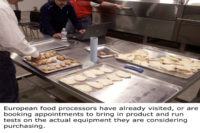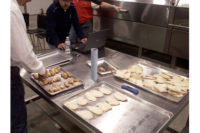Unitherm Food Systems unveils fully equipped test kitchen
It’s not too far a stretch to compare that with the purchase of food-processing machinery, where processors had to purchase “off the shelf.” In such instances, the capabilities of the equipment often dictated the cooking and freezing processes, resulting in a less-than-optimal taste and quality of the final product for the sake of high volumes that only automated machinery can deliver.
But the competitive food market takes no prisoners, and processors that don’t offer the best gustatory experience to the consumer will eventually go out of business. Hence, the need to get it right the first time.
This is where the shift toward equipment-testing kitchens comes in.
“The future of food-process machinery purchasing is going this way, where the customer can demand to go into a kitchen and actually try out their product on the machinery,” predicts David Howard, CEO of Unitherm Food Systems of Bristow, Okla. “Only then can they feel confident that the equipment best serves their operational parameters and expected results.”
Already recognized throughout the food-processing industry for its unique heat transfer systems that maximize yields and reduce processing times, Unitherm recently joined the small coterie of manufacturers that feature fully equipped test kitchens.
As one of the newer, more modern, iterations of manufacturer-owned test kitchens, it presents a textbook example of what type of environment awaits the producers of cooked vegetables, meats and frozen foods.
Upon arrival, guests are introduced to a $2.5-million, 25,000-square-foot kitchen dedicated to high-volume, high-speed food processing. Entry begins with a true “clean room” experience, with hygienic architectural products such as stainless-steel curbing, hands-free sinks, and stainless-steel floor drains.
The food processing area itself contains $8 million worth of fully operational production machines and product-handling equipment that can continuously feed as many as 10 different cooking processes: steaming, blanching, broiling, baking, searing, branding, grilling, and pasteurizing; convection impingement to infrared; with gas, electric or thermal oil. Cooking temps range from below boiling point all the way to 1,600 F.
Specific pieces of equipment include a flame broiler/griller with a series of eight ribbon burners to speed the browning and searing of foods such as mushrooms. In the case of poultry, the searing process seals in the natural oils before the product enters an oven. The oven, itself, incorporates a 16-inch-wide belt that spirals around the burners to the equivalent of 150 feet of belt, all within an 8-by-8-foot area.
No kitchen, test or otherwise, would be complete without a gas infrared oven, the most innovative of which utilizes a stainless-steel burner head for increased durability.
Likewise, quick-cooling “crusters” have attained de rigueur status for any food-processing plant that produces meat or poultry logs. Round out the chilling side of the business with a spiral freezer and a continuous impingement freezer. With the inclusion of an infrared or aquaflow pasteurizer, almost every imaginable aspect of the food-processing industry gets covered in today’s modern kitchen.
If that’s not enough, Unitherm’s kitchen, for one, comes staffed with design engineers willing to work hand-in-hand with food processors to modify any existing machinery into a customized cooking system. An on-site 3-D modeling system speeds the process.
Early feedback indicates that these kitchens are proving to be quite popular among food processors. Whether fire-roasting Portobello mushrooms, steaming potatoes, cooking vegetables and other ingredients for sauces and ravioli fillings or baking chicken tenders, experimenting with the equipment emboldens processors to proceed with confidence, knowing that the equipment will maximize yields, reduce processing times, increase food safety, and improve the taste of final product.
For further information contact: Unitherm Food Systems; 502 Industrial Road; Bristow, OK 74010; (918) 367-0197; fax (918) 367-5440; unitherm@unithermfoodsystems.com; or visit the Web site www.unithermfoodsystems.com.
Looking for a reprint of this article?
From high-res PDFs to custom plaques, order your copy today!






